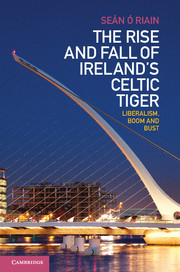Book contents
- Frontmatter
- Contents
- List of figures
- List of tables
- Acknowledgements
- 1 Liberalism in crisis
- 2 Ireland: between development and crisis
- 3 Capital: the triumph of finance*
- 4 Europe: between market and diversity
- 5 National politics: governing fragmentation, fragmented governance
- 6 Crisis: the difficult politics of development and liberalism
- Bibliography
- Index
2 - Ireland: between development and crisis
Published online by Cambridge University Press: 05 June 2014
- Frontmatter
- Contents
- List of figures
- List of tables
- Acknowledgements
- 1 Liberalism in crisis
- 2 Ireland: between development and crisis
- 3 Capital: the triumph of finance*
- 4 Europe: between market and diversity
- 5 National politics: governing fragmentation, fragmented governance
- 6 Crisis: the difficult politics of development and liberalism
- Bibliography
- Index
Summary
Ireland’s development dilemma
The crisis of 2008 was far from Ireland’s first Great Recession as an independent state. The 1950s had seen a largely agricultural, domestically oriented economy on the verge of collapse, with mass unemployment and emigration. A shift to a trade-oriented economy produced increased agricultural exports, the decline of protected domestic industries and a strong and persistent focus on attracting foreign direct investment (FDI). The 1960s and 1970s brought significant economic growth and some major social transformations – including the beginning of the ‘modern’ welfare state, the expansion of educational participation, changing family and gender relations, and the entry of Ireland into the European Economic Community (EEC) in 1973.
Nonetheless, the 1980s saw the arrival of a new crisis. Fuelled by government borrowing and cheap international finance in the late 1970s, Ireland’s political economy shared in the international debt crisis of the early 1980s. With emigration and unemployment again sky-rocketing, the limits of Ireland’s economic development and social transformation were clear. Female labour force participation remained extremely low and the overall employment rate within the economy was the lowest in the EU. Despite major inflows of foreign investment, the bulk of the Irish population remained dependent on the state for either employment or benefits – worse still, even in such an under-developed economy, inequality was among the highest in the Organisation for Economic Co-operation and Development (OECD) and was built into state policies (Breen et al., 1990).
- Type
- Chapter
- Information
- The Rise and Fall of Ireland's Celtic TigerLiberalism, Boom and Bust, pp. 32 - 67Publisher: Cambridge University PressPrint publication year: 2014



